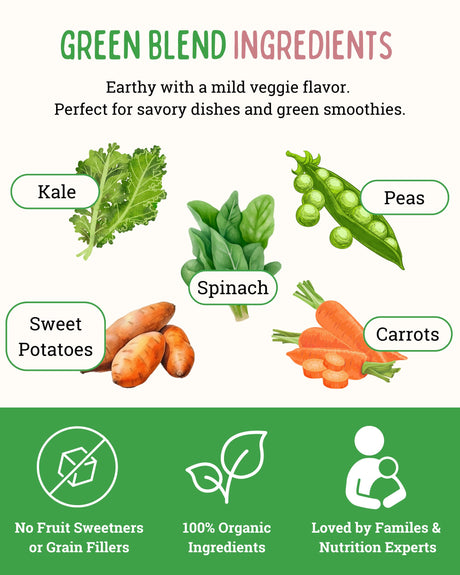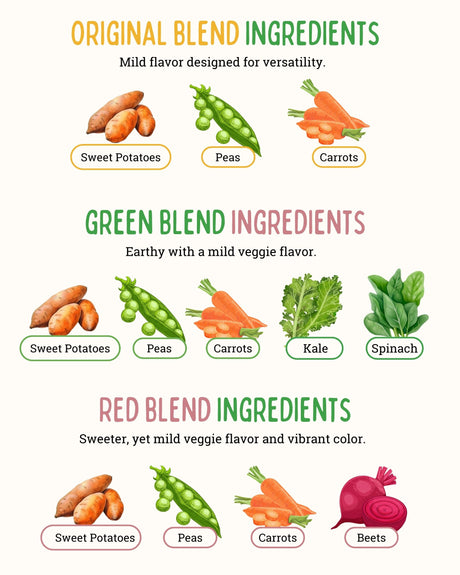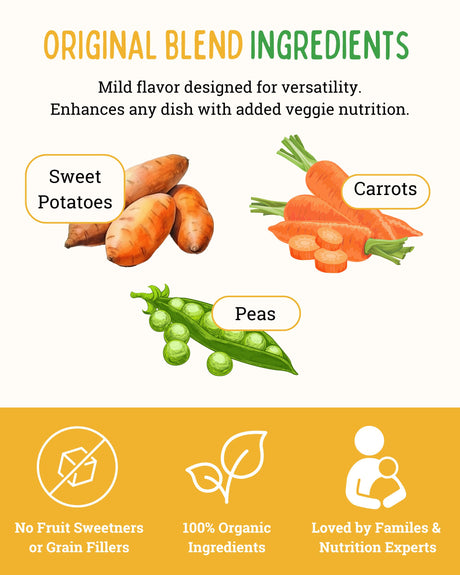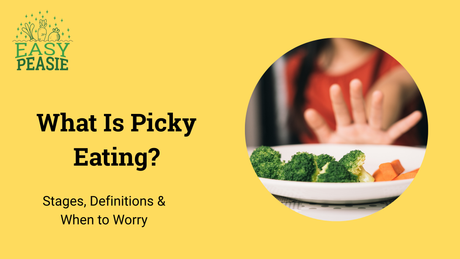Your child refuses every vegetable you put on their plate, yet you just watched them eagerly bite into a cherry tomato they picked from the garden themselves. It's the same tomato they've rejected at dinner for months, but somehow growing it changed everything.
This isn't magic or a coincidence, it's a well-documented phenomenon that researchers and parents have observed repeatedly. When children participate in growing vegetables, they're significantly more likely to try them and even enjoy them. Understanding why this works and how to make it happen in your own space can transform your child's relationship with vegetables.
Whether you have acres of land, a small backyard, or just a sunny windowsill, creating garden-to-table experiences can help even the most resistant eaters develop curiosity about vegetables. The key is understanding what makes growing different from simply serving, and how to maximize this powerful tool for building vegetable acceptance.
The Science Behind Garden-to-Table Success
Why Growing Works When Serving Doesn't
Research consistently shows that children who participate in growing vegetables eat more of them. Studies from farm-to-school programs demonstrate that kids involved in gardening consume more fruits and vegetables than their peers who don't garden, and this increased consumption often continues beyond the growing season.
The reasons go deeper than simple exposure. When children grow vegetables, multiple factors work together to reduce resistance and build acceptance.
Psychological ownership creates investment. When a child plants a seed, waters it, and watches it grow, they develop a sense of ownership over that plant. This vegetable isn't just food anymore—it's their accomplishment, their creation, their plant. Rejecting it feels different than refusing something that simply appeared on their plate.
Gradual exposure happens naturally through gardening. Unlike meal pressure where a child must decide immediately whether to eat something, gardening provides weeks or months of gentle exposure. They see the seeds, handle the plants, smell the leaves, watch the growth, and eventually harvest the produce. This extended, pressure-free exposure helps their nervous system adapt to the vegetable gradually.
Sensory desensitization occurs through the growing process. Children who are sensitive to certain textures or smells have multiple low-pressure opportunities to interact with vegetables in different states. They touch soil-covered carrots, smell tomato plants, feel fuzzy cucumber leaves—all without any expectation to eat anything.
The Peer Influence Factor
When multiple children garden together, peer modeling becomes incredibly powerful. Research shows that hearing peers have tried foods makes children more willing to try them themselves. In garden settings, kids naturally share discoveries ("This radish is crunchy!" "The peas are sweet!"), creating organic peer encouragement that's far more effective than adult pressure.
Autonomy and Control
Gardening gives children age-appropriate control over their food. They choose what to plant, decide when to harvest, and participate in preparation. This sense of autonomy reduces the power struggles that often accompany vegetable introduction at mealtimes. Instead of being told to eat vegetables, they're empowered to grow and explore them.
Creating Garden-to-Table Experiences at Any Scale
Large Yard Gardening
If you have outdoor space, even a small garden bed can produce meaningful results for vegetable acceptance.
Starting your garden:
- Begin with easy-to-grow, kid-friendly vegetables
- Create a dedicated "kids' garden" section they can manage
- Choose varieties with visible, quick results
- Include vegetables your child already accepts alongside new ones
Best vegetables for beginners:
- Cherry tomatoes: Quick to produce, sweet flavor, satisfying to harvest
- Snap peas: Edible pods, sweet taste, fun to pick
- Carrots: Exciting to pull from ground, naturally sweet
- Radishes: Fastest growing, immediate gratification
- Lettuce: Quick results, mild flavor
- Beans: Rapid growth, prolific producers
Child involvement strategies:
- Let them choose some vegetables to plant
- Give them their own tools (child-sized if possible)
- Assign specific plants as "theirs" to care for
- Create harvest rituals and celebrations
- Cook together immediately after harvest
Container Gardening for Limited Spaces
No yard? No problem. Container gardening on balconies, patios, or porches can be equally effective for building vegetable acceptance.
Container garden essentials:
- Choose containers with drainage holes (minimum 12 inches deep)
- Use quality potting soil, not garden dirt
- Place in area with 6+ hours sunlight daily
- Maintain consistent watering schedule
- Start small with 2-3 containers
Best container vegetables:
- Cherry tomatoes: Need large pots (5-gallon) but very productive
- Lettuce and spinach: Shallow roots, quick growing, continuous harvest
- Herbs: Basil, parsley, cilantro appeal to kids
- Peppers: Compact growth, colorful varieties
- Peas: Vertical growing saves space
Indoor Windowsill Gardens
Even without outdoor space, windowsill gardening provides valuable growing experiences.
Indoor growing options:
- Herbs in small pots (basil, parsley, chives)
- Microgreens in shallow trays
- Sprouts in jars (very quick results)
- Small lettuce varieties
- Dwarf tomatoes in large containers
Making indoor gardens successful:
- Choose south-facing windows for maximum light
- Consider grow lights for darker homes
- Use trays under pots to catch water
- Involve kids in daily watering and checking
- Harvest frequently to encourage growth
School and Community Gardens
Can't garden at home? Look for community options that provide similar benefits.
Finding garden opportunities:
- School garden programs and clubs
- Community garden plots (often have family sections)
- Library or church community gardens
- Junior gardening programs at botanical gardens
- Farm-to-table camps during summer
Age-Appropriate Garden Activities
Toddlers (2-3 Years)
Young toddlers can participate in gardening with appropriate expectations and supervision.
Toddler-friendly activities:
- Watering with small watering cans
- Putting seeds in holes (you dig)
- Harvesting cherry tomatoes, peas, beans
- Carrying harvest baskets
- Washing vegetables in water bins
Keep it simple: Focus on sensory experiences rather than actual growing responsibility. Let them explore soil texture, smell herbs, touch leaves.
Preschoolers (3-5 Years)
Preschoolers can take on more responsibility while still needing significant adult support.
Preschooler activities:
- Planting seeds with minimal help
- Watering assigned plants
- Pulling weeds (with guidance)
- Identifying ripe vegetables
- Counting harvest (math integration)
- Drawing or photographing plant growth
Building connections: Help them understand the seed-to-food process through simple explanations and observation.
School-Age Children (6-12 Years)
Older children can manage more complex tasks and understand longer-term gardening concepts.
School-age activities:
- Planning what to plant
- Reading seed packets and following instructions
- Measuring garden spaces
- Recording plant growth and observations
- Researching plant care
- Preparing simple recipes with harvest
- Sharing produce with neighbors/friends
Bridging Garden to Table
Harvest Rituals
Make harvesting special to maximize excitement and connection to vegetables.
Creating harvest experiences:
- Harvest together as a family activity
- Take photos of children with their harvest
- Let them choose which vegetables to pick
- Create "harvest baskets" they can carry
- Taste vegetables immediately after picking (often sweeter)
- Count and celebrate the harvest quantity
Immediate Preparation
The closer harvest is to eating, the stronger the connection children make.
Quick garden-to-table ideas:
- Rinse and eat tomatoes, peas, carrots immediately
- Create simple salads with lettuce just picked
- Steam green beans within hours of harvest
- Make fresh salsa with garden tomatoes and peppers
- Blend smoothies with garden spinach
Cooking together: Involve children in preparing what they grew. Even kids who typically refuse cooking participation often engage when it's "their" vegetables.
When Garden Vegetables Still Get Rejected
Not every child who gardens will immediately eat what they grow, and that's okay. The goal is exposure and building positive associations, not forced consumption.
If rejection continues:
- Keep offering without pressure
- Celebrate the growing success, not just eating
- Use garden vegetables in recipes where they're less visible
- Continue providing multiple exposures over time
- Consider products like Easy Peasie Veggie Powder Blends to ensure nutrition during the acceptance-building process
Remember that acceptance often develops slowly. A child who refuses garden tomatoes now might enthusiastically eat them next season after another year of growing experience.
Overcoming Common Obstacles
"We Don't Have Time"
Gardening doesn't require hours daily. Even 15 minutes several times per week provides meaningful engagement.
Time-saving strategies:
- Choose low-maintenance vegetables
- Use self-watering containers
- Create simple garden layouts requiring minimal weeding
- Focus on quality of engagement over quantity of time
- Accept that gardens don't need to be perfect
"We Don't Have Space"
Even the smallest spaces can support some growing experience.
Minimal space solutions:
- Single herb pot on kitchen windowsill
- Hanging planters on balcony rails
- Vertical growing systems
- Sprout jars requiring zero outdoor space
- Community garden participation
"We're Not Good at Gardening"
Perfect gardening skills aren't necessary for building vegetable acceptance through growing.
Embracing imperfection:
- Failures teach valuable lessons about trying again
- Kids learn resilience when plants don't survive
- Focus on the experience, not perfect produce
- Start with very easy vegetables almost guaranteed to succeed
- Use failures as learning opportunities without pressure
"My Child Has Sensory Sensitivities"
Children with sensory processing differences can still benefit from gardening with modifications.
Sensory-friendly approaches:
- Provide gloves if soil texture is overwhelming
- Start with less "messy" activities like watering
- Choose plants with pleasant smells (herbs often appeal)
- Allow observation without requiring hands-on participation initially
- Respect sensory boundaries while encouraging gradual involvement
Seasonal Considerations
Spring and Summer
Peak growing season offers maximum opportunities for vegetable acceptance.
Warm weather advantages:
- Fastest growing season for most vegetables
- Multiple harvests possible
- Comfortable outdoor time
- Fresh eating straight from garden
Popular spring/summer crops:
- Tomatoes, peppers, cucumbers, squash, beans, peas, lettuce, herbs
Fall
Extended growing season in many climates, often with fewer pest problems.
Fall growing:
- Cool-season crops thrive (lettuce, spinach, kale, carrots, radishes)
- Less watering needed
- Good time to start with beginners
- Harvest for holiday cooking
Winter
Indoor growing or planning activities maintain connection during dormant season.
Winter engagement:
- Indoor herb gardens
- Microgreens and sprouts
- Planning next season's garden
- Reading gardening books together
- Starting seeds indoors for spring
Long-Term Benefits Beyond Vegetable Acceptance
Life Skills Development
Gardening teaches responsibility, patience, and cause-and-effect relationships.
Scientific Understanding
Children learn biology, ecology, and environmental science through hands-on experience.
Physical Activity
Gardening provides exercise and outdoor time in age-appropriate ways.
Mental Health Benefits
Research shows gardening reduces stress and anxiety while improving mood and self-esteem.
Family Connection
Shared gardening creates positive family memories and bonding opportunities.
Making Garden-to-Table Sustainable
Starting Small
Begin with manageable projects that don't overwhelm family schedules or capabilities.
First-year recommendations:
- 2-3 easy vegetables
- Single raised bed or few containers
- Focus on learning and experience
- Accept imperfect results
- Celebrate any harvest, however small
Building Gradually
Expand gardening activities as children's interest and family capacity grows.
Year-by-year growth:
- Add new vegetables based on previous year's successes
- Increase garden size if first year went well
- Try more challenging plants as skills develop
- Include children more in decision-making
Creating Traditions
Establish garden-related family traditions that children anticipate.
Tradition ideas:
- First planting day celebration each spring
- Harvest feast using garden vegetables
- Seed selection ritual each winter
- Garden journaling or photo documentation
- Sharing produce with neighbors as community tradition
When Gardening Isn't Enough
While gardening significantly increases vegetable acceptance, it's not a complete solution for all feeding challenges. Children with significant sensory sensitivities, ARFID, or other feeding difficulties may need additional support beyond gardening experiences.
Products like Easy Peasie Veggie Powder Blends can provide nutritional security while working on acceptance through gardening and other exposure strategies. Two tablespoons provide nutrients equivalent to a cup of vegetables, supporting overall nutrition during the acceptance-building process.
Remember that building vegetable acceptance through gardening is a long-term strategy, not a quick fix. The goal is creating positive associations and gradual comfort with vegetables, which for many children translates to increased willingness to try and eventually enjoy them.
The magic of garden-to-table isn't just about growing food—it's about growing relationships, confidence, and curiosity. When children become active participants in the food journey rather than passive recipients of meals, everything changes. They develop ownership, pride, and connection that transforms vegetables from foreign objects to be feared into familiar friends they helped create.
Start wherever you are, with whatever space you have, and whatever vegetables seem most approachable. The perfect garden for building vegetable acceptance isn't the biggest or most productive—it's the one that actively involves your child and creates positive, pressure-free experiences with growing food.
This article is for educational purposes only and does not constitute medical advice. Always consult with your child's healthcare provider for concerns about eating patterns, growth, or development.











